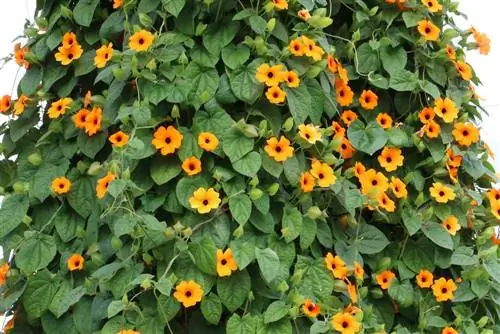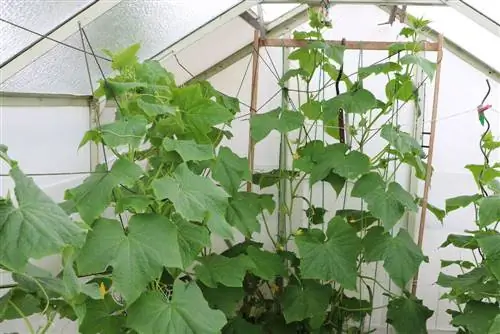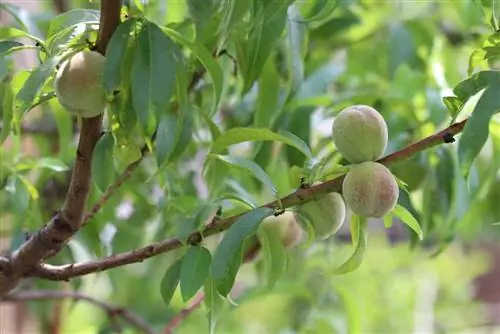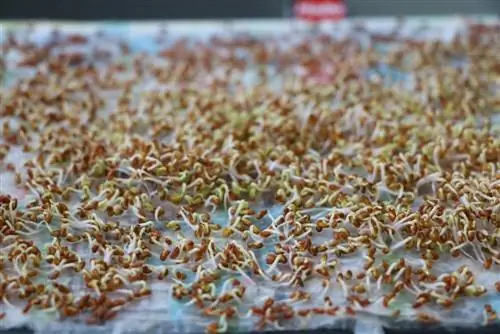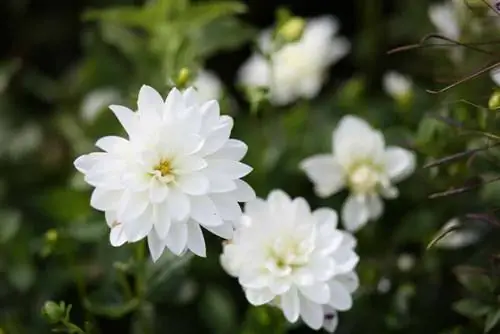- Author admin [email protected].
- Public 2023-12-17 03:39.
- Last modified 2025-06-01 06:48.
Strawberries are tasty and he althy, and the fruits taste even better when they are grown at home. A garden is not absolutely necessary; the plants can also grow in a pot on the terrace or balcony. With proper care, the plants thrive and harvest can take place from April to October. But the name is confusing, because the delicious fruits are not berries but belong to the rose family and to the collective nut fruits. The selection of different varieties is very extensive.
Location
In order to achieve a good harvest, strawberry plants need a location in full sun and protected from the wind. The plants should also be protected from excessive rain. If only a partially shaded location is available, wild or meadow strawberry varieties are ideal. It should also be noted that the plants planted in the garden bed are not placed in the same location every year. For potted plants, the soil can of course simply be replaced. The following locations are ideal:
- in the garden bed
- in a raised bed
- in the balcony box
- in a bucket
- in hanging pots
Tip:
If you don't plant your strawberry plants directly in the garden bed, but in a raised bed, a bucket or balcony box, you will protect the fruit from snails that like to nibble on them.
Substrate & Soil
When it comes to soil conditions, it is important to provide the strawberry plants with the nutrients they need. Above all, the optimal conditions include well-drained and deep soil. Otherwise, the substrate should be slightly acidic with a pH between 5.5 and 6.5 and humus. Compost can therefore be mixed into normal garden soil in the bed. If you plant in a pot, use loose potting soil that should only be lightly fertilized.
Pouring
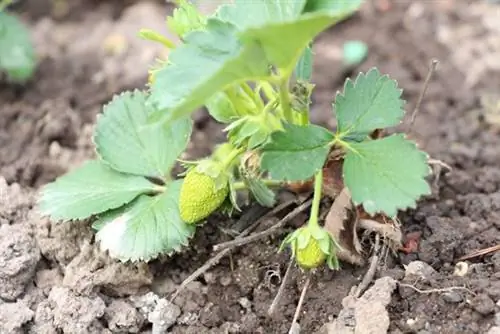
Strawberry plants are very vulnerable at the roots, which means they should never be exposed to waterlogging. It is better to water regularly, but only moderately. To ensure that the fruits are tasty and juicy, the plant must never dry out. But the leaves should not get wet either; when watering, it is important to ensure that you only pour into the soil and not onto the plants and their leaves. Therefore, the following should be taken into account when watering ideally:
- water regularly in hot, dry periods
- Ideally always in the morning
- watering in the evening promotes fungal diseases
- Provide sufficient water after planting, especially in early autumn
- cover permanently with mulch
- retains moisture
- Replace mulch with straw as fruit ripens
- this is how they stay clean
- only use rainwater or stale water for watering
Tip:
To avoid water getting to the leaves and thereby causing the plants to be infected by a fungus, you can water with so-called drip hoses. Only targeted drops of water drip onto the lower part of the plant.
Fertilize
Before planting, the substrate or garden soil used should be enriched with fertilizer. Compost, special organic fertilizer for strawberries or manure can be used for this purpose. However, when it comes to strawberry plants, less is more. If the plants receive too much fertilizer, the leaves will grow more luxuriantly, but this will delay the formation of flowers and the harvest will be smaller. The ideal way to fertilize is as follows:
- At the beginning of September when planting
- the flower systems are now being developed
- in spring when flowering begins
- fertilization is carried out before the straw is placed
- The multi-bearing varieties must be fertilized continuously
- flowers are formed here from spring to late summer
- Use berry fertilizer, rake it in regularly
- Slow-release fertilizers for strawberries are also suitable
- use this once at the start of the season
Plants in the garden - or raised bed
The tasty fruits are planted in late summer/autumn so that the fruits can form next year. The plants are hardy. This is especially true for garden strawberries that bear once. Varieties that bear fruit several times a year can also be planted in spring, in April. The plants that bear fruit several times then produce their first fruits in the summer. Since the strawberry plants cannot tolerate waterlogging, drainage should also be created in the garden or raised bed so that the water drains away better. To do this, stones, shards of pottery or gravel are placed in the planting holes before the plant is planted. Otherwise, the following should be noted when planting in the garden or raised bed:
- Place plants about 25 cm apart
- leave about 40 cm between the individual rows
- When inserting, make sure that the heart of the plants remains above the ground
- water well, especially when planting in late summer/autumn
- flowering in a pot or balcony box
Individual strawberry plants can also be planted in a pot or a hanging pot, but the balcony box offers space for a row of strawberries. Drainage should also be installed here to prevent waterlogging. To do this, shards of pottery or small stones are placed over the drainage holes. A plant fleece is placed over this so that the drainage is not blocked by soil. A part of the prepared soil is now added to this, then the planting proceeds as follows:
- Place strawberry plants at a distance of 25 cm apart
- carefully fill in the remaining soil
- the heart of the plants must not be covered with soil
- pour well
- Drain any excess water in the plate after half an hour
Repotting
Strawberries that have been cultivated in a container for several years should be repotted regularly so that the soil can be renewed. Because like the plants in the bed, the plants in the pot should not use the same soil for several years. The ideal time for repotting or replacing the soil is the same as the planting time. The procedure is as follows:
- carefully remove the plants
- completely remove the old soil from the pot, raised bed or balcony box
- Clean the pot
- Leave drainage
- fill in new, prepared soil
- Replanting strawberries
Propagate
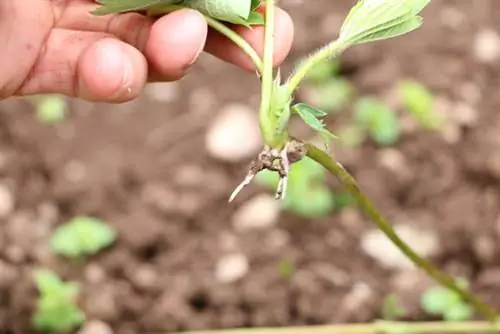
Strawberry plants can be propagated very easily because they form many offshoots throughout the year. If plants were purchased from the nursery at the beginning, they will be purchased for many years if they are cared for properly. When taking offshoots, it makes sense that they come from he althy mother plants. Therefore, the highest-yielding plants should be clearly marked during harvest, from which the offshoots for the new strawberry plants will later come. The procedure is as follows:
- cut off the offshoots with the spade
- plant in a prepared bed or container
- alternatively leave offshoots on the mother plants
- dig small pots in the ground around the plant
- fill with new soil and insert the cuttings
- the plants grow easier this way
Tip:
However, new, young plants should be bought every few years, because the offshoots lose their varietal characteristics over several generations. New plants should be taken care of at the latest when the harvest yield decreases.
Cutting
In spring the strawberry plants need pruning. So that the plants can grow he althily, all dead leaves should now be removed. In addition, in the summer, all runners that are not to be used for propagation are removed from the once-bearing varieties. Because these only weaken the plant and the harvest will be smaller the following year. Another cut should be made immediately after harvesting, removing all diseased and old leaves as well as the outer leaf crown. In the case of multi-bearing varieties, the runners, which also bear fruit, may only be cut back in the autumn after the last harvest.
Wintering
Strawberry plants are hardy and can therefore simply remain in the garden bed. This is particularly important because once-bearing strawberry plants should be planted in late summer/autumn and the plants therefore inevitably have to remain in the garden bed. Before winter, directly after the last harvest, the plants are cut back. In a garden bed, it is helpful to sprinkle additional mulch on the soil around the roots so that they are protected from severe frost. For pots and balcony boxes, the containers should also be wrapped in plant fleece or brushwood mats, as frost can hit the roots more quickly if the pots remain unprotected.
Tip:
If an unheated winter garden or a spring bed box is available, then the pots with the strawberry plants can also be stored there over the winter. A transparent film can also be stretched over the garden bed to act as a cold frame.
Care errors & illnesses
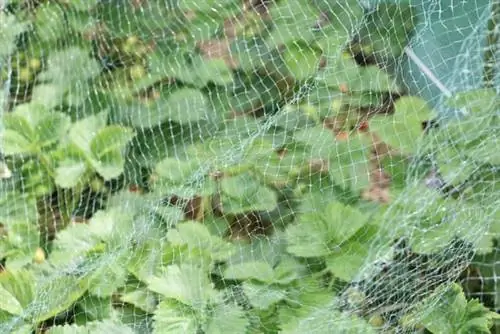
Unfortunately, strawberries are one of the most vulnerable plants in local gardens. They are therefore repeatedly threatened and attacked by diseases, but the cause is often also errors in care:
White and red spot disease
This is a fungus that attacks the leaves shortly before the fruit ripens. The disease can be recognized by the brown-red spots. The plant is weakened and can no longer ripen the fruits. There is no way to combat this, it should be prevented as follows:
- Avoid fertilizer containing nitrogen
- Mulch soil around the plant
- Planting plants in mixed culture with garlic
- remove the affected plant completely, do not leave it in the bed
- Spores can otherwise overwinter here
Strawberry mildew
When it gets warmer, mildew can also spread; the spores often spread explosively. If the strawberry plant has been infected, this will first become apparent in the white coating on the undersides of the leaves, later the leaves will turn red-brown or purple and finally curl up. The fruits are then attacked, no longer ripening and rot. The following steps should be taken to combat strawberry mildew:
- remove all affected parts of the plant
- spray with agents against mildew from the market
Gray rot
In warm, humid weather, gray rot often occurs on strawberry fruits, which is also caused by fungal infestation. The fruits turn brown when unripe and then begin to mold. The following measures can be taken against this:
- remove the affected fruits immediately
- water with onion extract or nettle manure
- don't let weeds grow, mulch soil or lay down straw
Tip:
A sunny location and a planting distance that allows air in between helps against this disease, because the leaves can dry out more quickly after rain.
Pests
Some pests also affect the strawberry plants and especially the tasty fruits. These include, above all, the strawberry blossom cutter as well as snails and the strawberry centipede.
Strawberry Blossom Cutter
The strawberry blossom pruner, as the name suggests, primarily attacks the flowers so that the fruits do not even develop. The infestation by the beetle is recognized by a small hole in the bud, the stem breaks off below the flower because it has been eaten. In the event of an infestation, you should proceed as follows:
- Collect beetles
- remove affected flowers and stems
- mulch with fern, female beetles don't like this
Snails
The snails, on the other hand, like the sweet fruit; they nibble on it and are no longer edible. To prevent infestation, you can proceed as follows:
- lay fresh straw around the strawberry plant
- cultivate the plants in a raised bed
- Cultivating plants in a pot or hanging basket
- lay out snail barriers in the garden bed
- use dried coffee grounds for this
- Snails react toxically to the caffeine they contain
- collect the snails in the evening or early morning
Strawberry Centipede
Another pest that likes to attack strawberry plants is the strawberry centipede. If small worms are discovered on the fruit, then these are the larvae of the pest. These eat every fruit they can get to and can cause great damage to the harvest. Beds with composted, humus-rich and moist soil are particularly prone to being attacked. The following steps should be taken to combat this:
- collect all larvae
- place clean straw on the ground around the plants
- Cultivate strawberry plants in mixed culture with marigolds, garlic or Tangetes
Tip:
If a strawberry millipede infestation is detected, it helps to place a cut potato with the cut side down on the ground. The pests like to hide under this and can be picked up the next morning.


